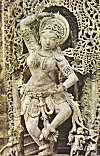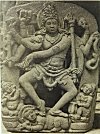History of Indian Dance
by K. L. Kamat
First Online: August 13, 2000
Last Updated: December 07, 2024
History of Indian Dance
The dance heritage of India is at least 5000 years old. A dancing girl figurine was found in the ruins of Mohenjodaro and is dated approximately 2nd Century B.C. Many group dancing sequences are depicted in exquisite rock paintings of Bhimbetaka caves of Madhya Pradesh. The apsaras (Celestials) dancers are carved at the gateways of Sanchi. The wall paintings of Ajanta and Ellora, the sculptures of Khajuraho, the temple walls of Hoysala dynasty, stand ample evidence for popularity of Indian dances from ancient times.
Through the centuries the dances have been used as a vehicle of worship and expression of emotions in India. The temple dancers (Devadasis) have led a very austere lives in order to perform sacred dances to please Gods and Goddesses. The Devadasi system is still prevalent in some states of India. In Karnataka they are dedicated to the Goddess Yellamma of Savadatti. In Orissa, they are appointed to perform various activities of the temple.
 A Temple Woman Dancing to Please Goddess |
 Dancer from a Medieval Sculpture |
 Lord Shiva and His Cosmic Dance |
The Portuguese traveler, Domingo Paes visited the Vijayanagar kingdom in 1520-22 A.D. and has left behind a vivid description of the dancers he saw in the kingdom. His original chronicles have been preserved in the Bibliotheque nationale de France, in Paris. He visited special dancing halls where young female dancers were given intensive training. The walls were decorated with paintings depicting various dancing poses which helped the dancers to correct their steps. The king, Krishna Devaraya himself took very keen interest in their dance education and periodically visited these halls. During the Navaratri festival celebrations the dance performances were given great importance. The dancers were adorned with innumerable ornaments, made out of gold, pearls, and diamonds. "At times the jewelry they wore use to be so heavy that the dancers were supported by the other women who accompany them".
Dance in Indian Society
Nataraja, the dancing Lord Shiva, is the supreme manifestation of Indian dance. The moon which he adorns in his head is the symbol complete control of senses. The serpents wound around his body is the proof of his complete control over vital life forces. His foot raised high over the wicked demon, a symbol of triumph over the ego.
The Indian dances have sprung from the religious urges of her people. Its thematic contents are based on the rich mythological lore of the country. The dance technique is based on a few ancient treatises, like the Natya Shastra of sage Bharata, which were written nearly two millennia ago. The Indian dances consists of three distinct types. "Nritta" is pure and simple dance with movements of body and limbs. "Nritya" is linked with facial expressions, hand gestures and symbolic body poses. "Natya" has the elements of a drama which is introduced through the use of spoken world. All the types involve the use of "mudras", which are well developed types of gestures during the dance. The dancers use their entire body to communicate with the audience.
The major Indian classical dances are: Bharata Natyam, Kathakali, Kathak and Manipuri, Kuchipudi, Odissi and Mohini Attam. In addition, there are innumerable folk and tribal dances spread all over the country.
![]()
See Also:
- The Dances of India - Table of Contents
- Theatrical Arts of India - Table of Contents
- Folk Dances of Karnataka
- The Arts of India
- Kamat PictureSearch results for Dances

